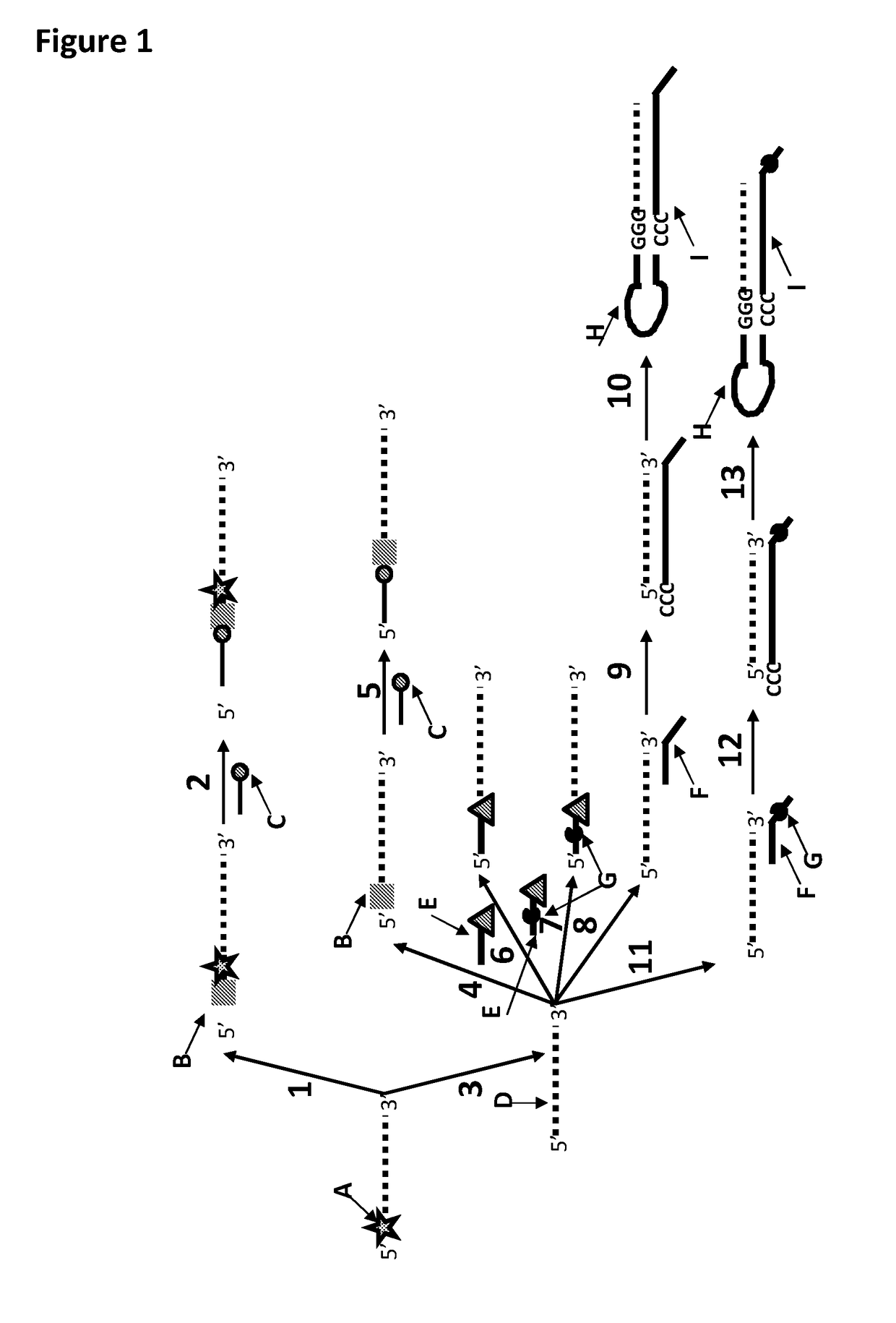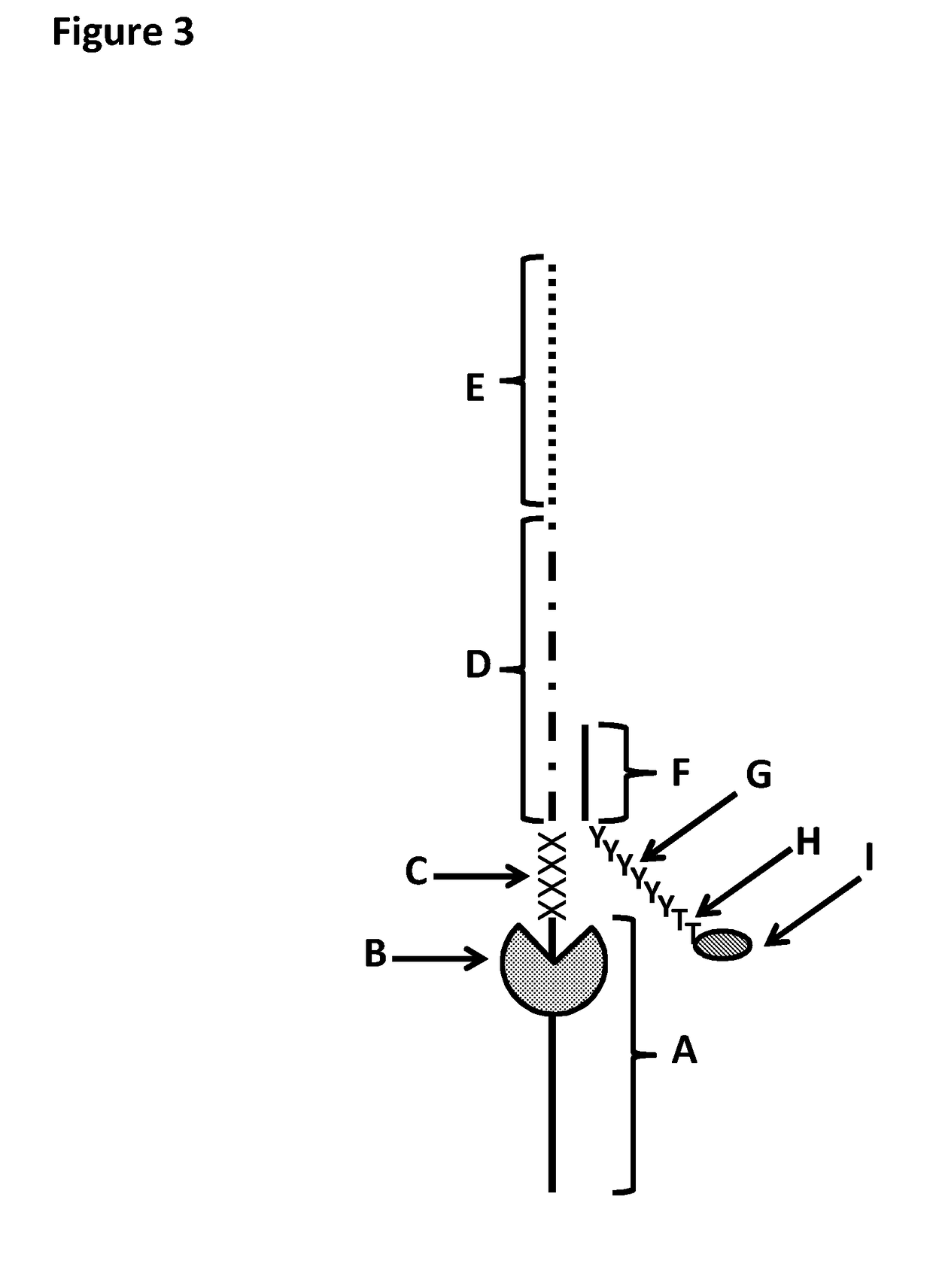Method for nanopore RNA characterisation
- Summary
- Abstract
- Description
- Claims
- Application Information
AI Technical Summary
Benefits of technology
Problems solved by technology
Method used
Image
Examples
example 1
[0371]This example shows the sample preparation procedure which 1) extended the RNA region of an RNA / DNA strand, 2) annealed an anchor, 3) bound an enzyme and then 4) tested the resultant strand in an electrophysiology experiment. This example illustrated that it was possible to use a DNA helicase (T4 Dda—E94C / A360C (SEQ ID NO: 14 with mutations E94C / A360C and then (ΔM1)G1)) to control the movement of a synthetic DNA / RNA strand (DNA leader attached to an RNA strand, shown in FIG. 3) through an MspA nanopore.
Materials and Methods
[0372]1.1 Extension of the 3′ End of an DNA / RNA Strand using Poly(U) Polymerase
[0373]The reagents listed in Table 3 below were mixed and incubated at 37° C. for 10 minutes. The mixture was then purified using Agencourt Ampure SPRI beads at a ratio of 1.8 μL SPRI beads per μL of sample. This sample was known as sample 1 (DNA / RNA 2). FIG. 4 shows that the polymerase extension reaction was successful as a broad band labelled Y in the figure corresponded to varia...
example 2
[0381]This example shows the ligation of a DNA strand (SEQ ID NO: 21) to an RNA strand (SEQ ID NO: 19) using T4 DNA ligase.
Materials and Methods
2.1 Ligation of a DNA Strand to an RNA Strand Using T4 DNA Ligase
[0382]The reagents listed in Table 5 below were mixed and placed on a thermocycler. The thermocycler was set to the program in Table 6 below. The samples were then analysed using a 10% PAGE TBE-Urea denaturing BioRad Criterion Gel which was run at 140 V for 60 minutes.
TABLE 5StockFinalReagentVolumeConcentrationConcentration5′ phosphate RNA0.3 ul50uM1uM(SEQ ID NO: 19)T4 DNA ligase buffer1.510 x1 xT4 DNA ligase 1 ul10U / ul10UDNA splint (SEQ ID NO: 20)0.3 ul50uM1uMCy3 DNA (SEQ ID NO: 21)0.6 ul50uM2uMATP0.3 ul50mM1mMNF H2O 11 ulTotal 15 ul
TABLE 6Number ofCyclesStepTemp (° C.)Time1Ligate251:00:001Denature650:10:00
Results
[0383]The TBE-Urea denaturing gel was used to analyse the ligation of CY3 DNA (SEQ ID NO: 21) to RNA (SEQ ID NO: 19). FIG. 8, lanes 2-3 showed the control reactions ...
example 3
[0384]This example shows a sample preparation procedure that chemically attached a DNA strand to an RNA strand using click chemistry. This was carried out on two different samples one of which had a fluorescent group attached to the DNA, in order for the chemical attachment step to be confirmed using gel electrophoresis. The DNA / RNA strand that did not have a fluorescent group attached was then tested in an electrophysiology experiment. This example illustrated that it was possible to use a DNA helicase (T4 Dda—E94C / A360C (SEQ ID NO: 14 with mutations E94C / A360C and then (ΔM1)G1)) to control the movement of an RNA strand that was attached to a non-RNA polynucleotide by copper-mediated click-chemistry (cartoon representation of the construct is shown in FIG. 10) through an MspA or Lysenin nanopore.
Materials and Methods
3A.1 Click Reaction of DNA X1 to RNA X1
[0385]The RNA X1, DNA X1 and splint X1 (listed in Table 7 below) were mixed in buffer (TRIS-NaCl (500 mM-2.5M) pH 8). The DNA X1,...
PUM
| Property | Measurement | Unit |
|---|---|---|
| Length | aaaaa | aaaaa |
| Size | aaaaa | aaaaa |
| Current | aaaaa | aaaaa |
Abstract
Description
Claims
Application Information
 Login to View More
Login to View More - R&D
- Intellectual Property
- Life Sciences
- Materials
- Tech Scout
- Unparalleled Data Quality
- Higher Quality Content
- 60% Fewer Hallucinations
Browse by: Latest US Patents, China's latest patents, Technical Efficacy Thesaurus, Application Domain, Technology Topic, Popular Technical Reports.
© 2025 PatSnap. All rights reserved.Legal|Privacy policy|Modern Slavery Act Transparency Statement|Sitemap|About US| Contact US: help@patsnap.com



